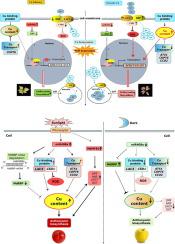Journal of Advanced Research ( IF 10.7 ) Pub Date : 2022-11-10 , DOI: 10.1016/j.jare.2022.11.005 Yujing Hu 1 , Jiayi Ji 2 , Hao Cheng 1 , Rongli Luo 1 , Jie Zhang 1 , Wenjing Li 1 , Xingsui Wang 1 , Jie Zhang 1 , Yuncong Yao 1

|
Introduction
The expression of miR408 is affected by copper (Cu) conditions and positively regulates anthocyanin biosynthesis in Arabidopsis. However, the underlying mechanisms by which miR408 regulates anthocyanin biosynthesis mediated by Cu homeostasis and reactive oxygen species (ROS) homeostasis remain unclear in Malus plants.
Objectives
Our study aims to elucidate how miR408a and its target, basic blue protein (BBP) regulate Cu homeostasis and ROS homeostasis, and anthocyanin biosynthesis in Malus plants.
Methods
The roles of miR408a and its target BBP in regulating anthocyanin biosynthesis, Cu homeostasis, and ROS homeostasis were mainly identified in Malus plants.
Results
We found that the BBP protein interacted with the copper-binding proteins LAC3 (laccase) and CSD1 (Cu/Zn SOD superoxide dismutase), indicating a potential crosstalk between Cu homeostasis and ROS homeostasis might be mediated by miR408 to regulate the anthocyanin accumulation. Further studies showed that overexpressing miR408a or suppressing BBP transiently significantly increased the expression of genes related to Cu binding and Cu transport, leading to anthocyanin accumulation under light induction in apple fruit and Malus plantlets. Consistently, opposite results were obtained when repressing miR408a or overexpressing BBP. Moreover, light induction significantly increased the expression of miR408a, CSD1, and LAC3, but significantly reduced the BBP expression, resulting in increased Cu content and anthocyanin accumulation. Furthermore, excessive Cu significantly increased the anthocyanin accumulation, accompanied by reduced expression of miR408a and Cu transport genes, and upregulated expression of Cu binding proteins including BBP, LAC3, and CSD1 to maintain the Cu homeostasis and ROS homeostasis in Malus plantlets.
Conclusion
Our findings provide new insights into the mechanism by which the miR408a-BBP-LAC3/CSD1 module perceives light and Cu signals regulating Cu and ROS homeostasis, ultimately affecting anthocyanin biosynthesis in Malus plants.
中文翻译:

miR408a-BBP-LAC3/CSD1模块调节苹果植物光诱导过程中铜稳态和ROS稳态之间的串扰介导的花青素生物合成
介绍
拟南芥中miR408的表达受铜 (Cu) 条件影响并正向调节花青素生物合成。然而,在苹果属植物中, miR408调节 Cu 稳态和活性氧 (ROS) 稳态介导的花青素生物合成的潜在机制仍不清楚。
目标
我们的研究旨在阐明miR408a及其靶标碱性蓝色蛋白 ( BBP ) 如何调节苹果属植物中的 Cu 稳态和 ROS 稳态以及花青素生物合成。
方法
miR408a及其靶标BBP在调节花青素生物合成、Cu 稳态和 ROS 稳态中的作用主要在苹果属植物中发现。
结果
我们发现BBP蛋白与铜结合蛋白LAC3(漆酶)和CSD1(Cu/Zn SOD超氧化物歧化酶)相互作用,表明Cu稳态和ROS稳态之间潜在的串扰可能由miR408介导来调节花青素的积累。进一步的研究表明,过表达miR408a或抑制BBP会短暂显着增加与 Cu 结合和 Cu 转运相关的基因表达,导致苹果果实和苹果幼苗在光诱导下花青素积累。一致地,当抑制miR408a或过表达BBP时,获得了相反的结果。此外,光诱导显着增加了miR408a、CSD1和LAC3的表达,但显着降低了BBP的表达,导致Cu含量增加和花青素积累。此外,过量的铜显着增加了花青素的积累,伴随着miR408a和铜转运基因的表达减少,以及铜结合蛋白(包括BBP、LAC3和CSD1)的表达上调,以维持苹果属植株中铜稳态和ROS稳态。
结论
我们的研究结果为miR408a-BBP-LAC3/CSD1模块感知光和 Cu 信号调节 Cu 和 ROS 稳态,最终影响苹果属植物花青素生物合成的机制提供了新的见解。



























 京公网安备 11010802027423号
京公网安备 11010802027423号